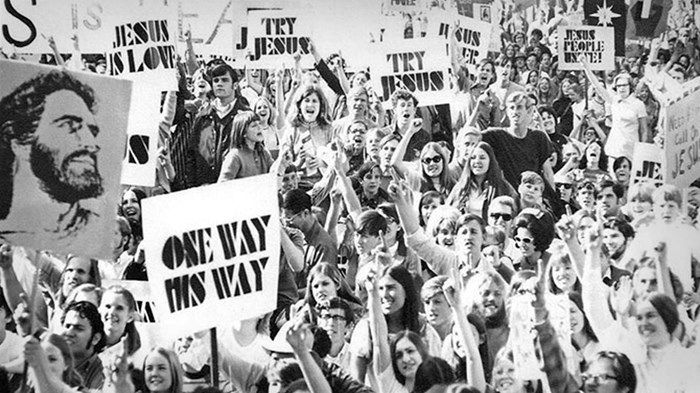
Christian youth culture has become such a prominent, pervasive fixture on the American scene-witness the multi-million-dollar Christian contemporary music industry-that it may be hard to think of it as even having an origin. Yet, as we saw in last week's newsletter, not only is the idea of a distinct, youthful way of "doing" Christianity now over half a century old, but it owes much to the energies and advocacy of the now-venerable Billy Graham.
Last week we caught a glimpse of Billy in the mid-1940s, with pastel suit and pomaded hair, delivering the gospel in between swing-band instrumentals and girl-trio numbers to crowds of bobby-soxed and zoot-suited teens. We also saw him as one of the central personalities and energetic promoters of the influential Youth for Christ organization.
This week we follow Graham into the late 1960s as, disguised in dark glasses, old clothes, ball cap, and a false beard, he joins with demonstrating youth at City University in New York. And as he sits with his wife, Ruth, at their family home in Montreat, listening intently to a collection of rock albums. And as (again disguised) he mingles and raps with the audience at a 1969 Miami rock concert, to the strains of the Grateful Dead and Santana. And as (undisguised) he takes that same stage, by invitation of the concert promoters, to tell the partying masses how to "get high without hang-ups and hangovers" on Jesus.
During those years marked by youthful unrest, we can also peer discreetly into Graham's home life, where, much to the distress of his famous father, the teenaged Franklin Graham smokes, drinks, and flouts authority. Though Billy has his "human" moments as he confronts this rebellion (he once candidly admitted that his reaction on first seeing a group of demonstrating hippies was a strong desire to "shave them, cut their hair, bathe them, and then preach to them"), yet Graham still responds to Franklin with a compassionate patience that also marks his public interaction with his son's generation.
So, for example, following him into the early 1970s, we find Graham riding in the New Year's Day 1971 Pasadena, California, Tournament of Roses Parade, where he picks up the raised-index-finger gesture and "One Way" chant of the Jesus People and echoes them back to appreciative crowds all along the parade route. And we read Graham, in his 1971 book, The Jesus Generation (Zondervan), rejoicing that the Jesus People movement heralds a new spiritual awakening for America.
Throughout this period, Billy Graham passed lightly over the stylistic eccentricities and excesses of the Jesus People and exulted over their on-fire faith—a reaction relatively rare among Christian conservatives.
At one point, Graham signaled solidarity with that generation by allowing his hair to grow down over his collar. After a TV appearance, the evangelist received a flood of negative letters for his trouble—some even enclosing money to pay for the haircut. Not every Christian was pleased with Billy's new friends and Billy's new attitude.
Graham advocated persistently for the "Jesus Revolution" in his Crusades of the early 1970s (these audiences for these crusades were made up of 60 to 70 percent young people) and threw significant support behind Explo '72, the period's "Christian Woodstock."
The age's young radicals for Christ responded in kind. At a Chicago Graham crusade in the summer of 1971, Jesus People surrounded disruptive demonstrators, praying for them and chanting the name of Jesus to drown out their blasphemies. Later in the crusade a young suburban Chicago discipleship-group leader, Ron Rendelman, passed along the message: "Tell Billy Graham: 'The Jesus People love him.'"
In short, Graham became for the youth of the Age of Aquarius what he had been for the zoot-suiters and bobby-soxers of the 1940s: not only a culturally savvy evangelist but an influential friend and advocate.
His final impact on the "Jesus Generation" is impossible to measure. But in a fascinating account of this period, "'One Way': Billy Graham, the Jesus Generation, and the Idea of an Evangelical Youth Culture" (Church History 67 [March 1998], 83-106), historian Larry Eskridge suggests a thought exercise to help us gauge that impact:
"It is tempting to speculate," says Eskridge, "what might have occurred had someone as visible and important in evangelical circles as Billy Graham actively led a fight against the Jesus People, their music, worship styles, and relational stance to the larger youth culture. Surely, such a crusade would have slowed the development of the evangelical youth culture that evolved in the 1970s and 1980s."
More positively, Eskridge argues, "Without the welcoming arms of Billy Graham and other evangelical leaders, there would have been no bridge 'back' for thousands of refugees from the counterculture-just another disillusioning hassle and prolonged battle with another facet of the Establishment." What the sympathetic advocacy of a prominent figure like Graham did was to preserve a "middle ground" upon which the day's adolescents could negotiate the "mine fields of culture and identity" that perennially confront that age group.
Graham's high-profile sojourn with the Jesus People, like his earlier efforts with Youth for Christ, helped ensure the continued growth of Christian youth culture. And it did so by smoothing the way for thousands of prodigal sons and daughters to return to the "old-fashioned" Christian faith of their parents.
This newsletter amounts to a summary of Larry Eskridge's vivid and penetrating article in Church History, mentioned above. I highly recommend it, if you can track it down.
Among other sources, Eskridge cites the following on the Jesus Movement: Robert S. Ellwood, One Way: The Jesus Movement and its Meaning (Englewood Cliffs, N.J.: Prentice-Hall, 1973), David DiSabatino, "History of the Jesus Movement" (M.A. Thesis, McMaster University, 1994), and Ronald M. Enroth, Edward E. Ericson Jr., And C. Breckinridge Peters, The Jesus People: Old-Time Religion in the Age of Aquarius (Grand Rapids, Mich.: Eerdmans, 1972).
For more on Graham's youth-culture activities, see standard biographies such as those by John Pollock and William Martin.
Chris Armstrong is managing editor of Christian History magazine.
Copyright © 2002 Christianity Today. Click for reprint information

Support Our Work
Subscribe to CT for less than $4.25/month




























